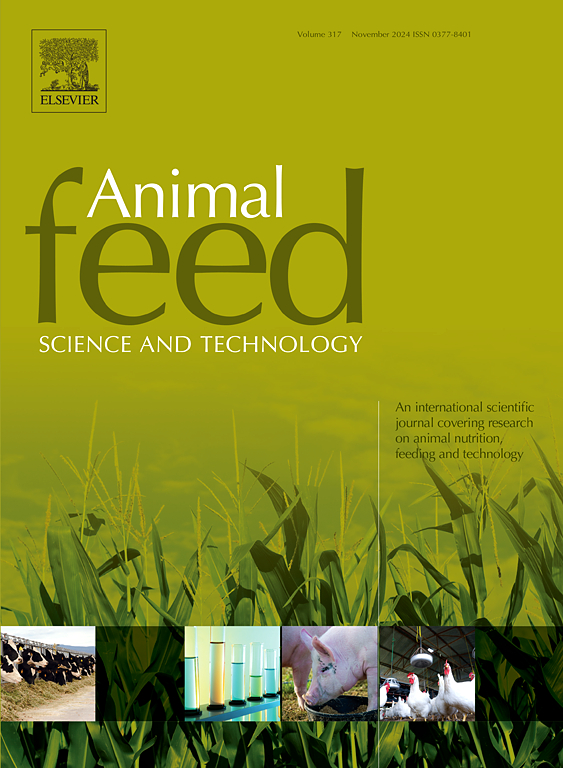Evaluation of processed soy ingredients for largemouth bass (Micropterus nigricans) fingerlings on growth performance, intestinal health, and disease susceptibility
IF 2.5
2区 农林科学
Q1 AGRICULTURE, DAIRY & ANIMAL SCIENCE
引用次数: 0
Abstract
Largemouth bass is a critically important sportfish in the United States, and cultural practices have led to the potential of this species as a food fish. The aquaculture industry relies heavily on fishmeal (FM) as a source of protein in dietary formulations. Although an excellent protein source, FM is subject to supply shortages, increased demand, and variable pricing. Soy proteins are also considered an excellent protein source, but high inclusions may negatively influence growth performance and health in several aquaculture species. To evaluate the potential of soy proteins in largemouth bass diets, a feeding trial was conducted with largemouth bass fingerlings (initial weight: 6.15 ± 0.11 g) fed four formulated diets. Alongside a basal diet, the experimental diets included a solvent-extracted soybean meal (SBM), soy protein concentrate (SPC), or enzyme-treated soybean meal (ESBM), all replacing 50 % of FM. Endpoint growth results revealed no significant differences in growth parameters, but a difference in feed conversion ratio [(1.14–1.28); P < 0.001]. Qualitative histological differences were not significant for the thickness of the lamina propria, the thickness of connective tissue beneath folds, and vacuolization (P ≥ 0.344). Gene expression of targeted cytokines in the intestine were not significant for il1b, il8, il10, and tgfb (P ≥ 0.429). Additionally, no differences were detected in the alpha diversity of the gut microbiome, richness, evenness, or the Shannon index (P ≥ 0.082). However, significant differences in beta diversity were detected for Bray-Curtis (P = 0.002) and unweighted-UniFrac (P = 0.038). Significant differences in blood sera were found for lysozyme activity, albumin, alkaline phosphate, alanine transaminase, creatine, globulin, and total protein concentrations (P ≤ 0.044). Finally, the largemouth bass were subjected to an in vivo immersion-based challenge with Flavobacterium columnare (isolate ARS-LMB-23–5; 4.98 × 106 colony-forming units (CFU) mL−1 exposure). No significant differences in endpoint cumulative percent mortality (CPM) were detected among dietary treatment-fed largemouth bass [(81.7–100.0 %); P = 0.530], but a difference in Kaplan-Meier survival curves (P < 0.001) was discerned via Mantel-Cox testing. The comparable growth performance observed in this study demonstrates the potential of replacing FM with various soy protein types in largemouth bass fingerlings.
黑鲈(Micropterus nigricans)鱼种加工大豆成分对生长性能、肠道健康和疾病易感性的评价
在美国,大口黑鲈是一种非常重要的运动鱼类,文化实践导致了这个物种作为食用鱼的潜力。水产养殖业严重依赖鱼粉(FM)作为饲料配方中的蛋白质来源。虽然是一种很好的蛋白质来源,但FM受到供应短缺、需求增加和价格变化的影响。大豆蛋白也被认为是一种极好的蛋白质来源,但高内含物可能对一些水产养殖物种的生长性能和健康产生负面影响。为评价大豆蛋白在大口黑鲈饲料中的应用潜力,本试验采用初始体重为6.15 ± 0.11 g的大口黑鲈鱼种饲喂4种配制饲料。除基础饲粮外,试验饲粮包括溶剂提取豆粕(SBM)、大豆浓缩蛋白(SPC)或酶处理豆粕(ESBM),均替代50% %的鱼粉。终点生长结果显示,生长参数无显著差异,但饲料系数存在差异[(1.14-1.28)];P & lt; 0.001]。固有层厚度、褶皱下结缔组织厚度和空泡化的定性组织学差异无统计学意义(P ≥ 0.344)。肠道中il - 1b、il - 8、il - 10和tgfb的靶向细胞因子基因表达不显著(P ≥ 0.429)。此外,在肠道微生物组的α多样性、丰富度、均匀度或Shannon指数方面没有发现差异(P ≥ 0.082)。然而,布雷-柯蒂斯(P = 0.002)和未加权的unifrac (P = 0.038)的β多样性存在显著差异。血清溶菌酶活性、白蛋白、碱性磷酸盐、丙氨酸转氨酶、肌酸、球蛋白和总蛋白浓度差异有统计学意义(P ≤ 0.044)。最后,用柱状黄杆菌(Flavobacterium柱状黄杆菌)分离物ARS-LMB-23-5;4.98 × 106菌落形成单位(CFU) mL−1暴露)。各组大黑鲈的终点累积死亡率(CPM)无显著差异[81.7-100.0 %];P = 0.530],但通过Mantel-Cox检验发现Kaplan-Meier生存曲线差异(P <; 0.001)。本研究中观察到的可比生长性能表明,在大口黑鲈鱼种中,用各种大豆蛋白代替FM具有潜力。
本文章由计算机程序翻译,如有差异,请以英文原文为准。
求助全文
约1分钟内获得全文
求助全文
来源期刊

Animal Feed Science and Technology
农林科学-奶制品与动物科学
CiteScore
6.00
自引率
6.20%
发文量
266
审稿时长
3 months
期刊介绍:
Animal Feed Science and Technology is a unique journal publishing scientific papers of international interest focusing on animal feeds and their feeding.
Papers describing research on feed for ruminants and non-ruminants, including poultry, horses, companion animals and aquatic animals, are welcome.
The journal covers the following areas:
Nutritive value of feeds (e.g., assessment, improvement)
Methods of conserving and processing feeds that affect their nutritional value
Agronomic and climatic factors influencing the nutritive value of feeds
Utilization of feeds and the improvement of such
Metabolic, production, reproduction and health responses, as well as potential environmental impacts, of diet inputs and feed technologies (e.g., feeds, feed additives, feed components, mycotoxins)
Mathematical models relating directly to animal-feed interactions
Analytical and experimental methods for feed evaluation
Environmental impacts of feed technologies in animal production.
 求助内容:
求助内容: 应助结果提醒方式:
应助结果提醒方式:


